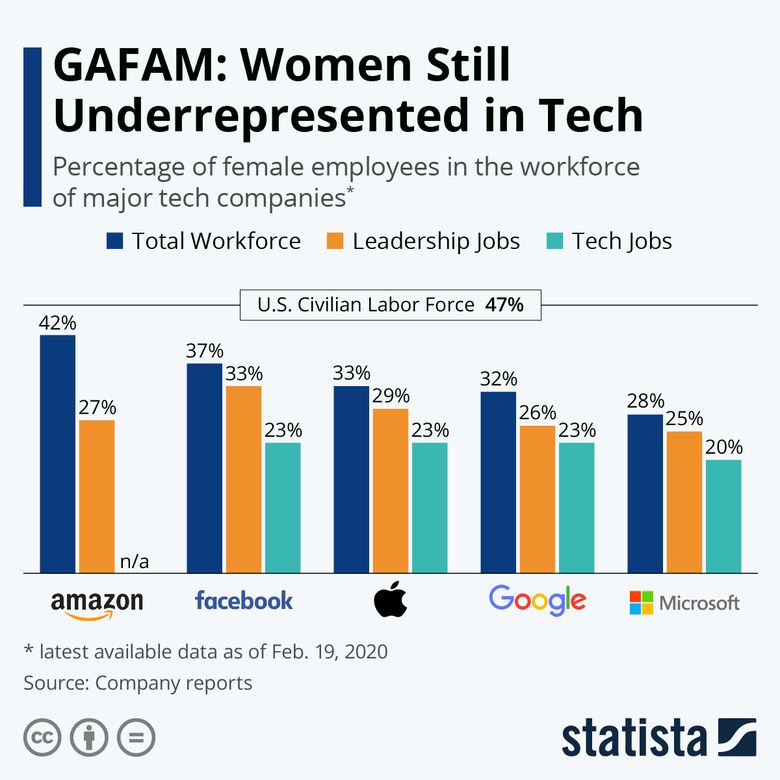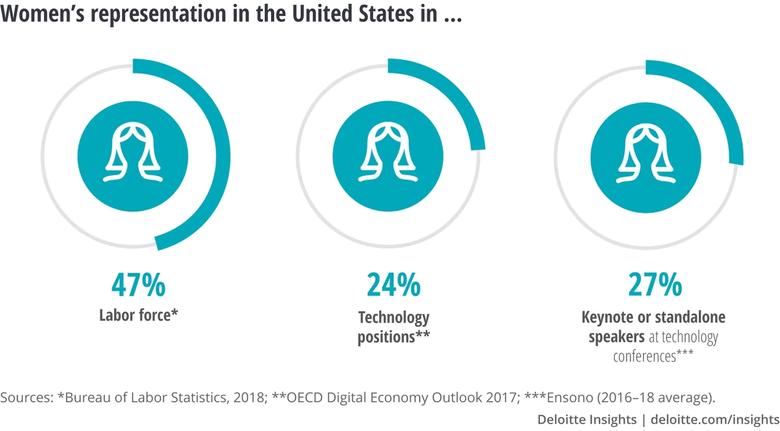Historically Unutilized Talent: How Women Are Left Out of the Tech Industry
Only 24% of technology positions are held by women. How do we close the gender gap in tech?
The gender gap in the workplace has been a persistent dilemma worldwide, but it has heavily affected the tech industry as evidenced by some of the largest gaps in representation. With increasing calls for reforms focused on gender equality, focus on this problem has increased with heightened scrutiny and concern.
A New York Times article discusses a study conducted by the Allen Institute, which found that gender parity within the tech industry, specifically in computer science roles, would not be achieved for more than another century if current trends continue. Countless studies show teams with diverse backgrounds yield better, more sophisticated outcomes with higher levels of innovation. Therefore, the gender gap is not only an injustice to women aspiring for a tech career, but also a damaging missed opportunity for the companies perpetuating these trends.
Diagnosing the Problem

Image Credit: Statista; Article titled "GAFAM: Women Still Underrepresented in Tech".
In 2018, the Bureau of Labor Statistics reported that women make up around 47% of the labor force in America, but the OECD Digital Economy Outlook reports that only 24% of technology positions are held by female employees. Furthermore, Ensono found that only 27% of keynote or standalone speakers at technology conferences were women (2016-2018). Though speakers at these leadership conferences are proportionate to the gender makeup of tech jobs, they are not representative of the proportion of women making up the labor force.
Organizations contribute to inequality in a number of ways, including
- Referral hiring: you need an "in" to the organization, which leads to well connected candidates (from similar backgrounds) being prioritized.
- Subjective evaluations: unstructured evaluation criteria leads to bias during performance reviews.
- Secretive pay decisions: employees are discouraged from sharing pay information. This allows companies to discriminate behind the scenes, which skews in favor of more "traditional" (i.e. white, male, etc) candidates.
These staggering gaps are getting worse, not better. The number of Black, Latina, and Native American women receiving computing degrees has dropped from 7% to 4% in the past decade alone, a reduction of 40%. McKinsey & Company published an article containing the exhibit below, which gives a more visual representation of the gap between men and women in these tech roles.

What Can Be Done?
Deloitte Insights
Deloitte Insights, a publication under the parent company Deloitte, published an article detailing concrete steps both employers can take to access this historically underutilized talent. They focus specifically on holding diverse events and giving minorities a voice. Their recommendations include (but are not limited to) the following:
Diversity guidelines for events
“Consider drafting and posting diversity guidelines or policies for events your organization participates in or runs.”
Diversity of speakers
“Commit to creating more diverse speaker lineups. Rather than inviting the same luminaries year after year, look for upcoming stars—perhaps at a level below where you ordinarily look. Consider highlighting diversity guidelines in your calls for proposals/speakers, asking speakers for recommendations of additional experts from underrepresented groups, using professional networking sites to seek out novel speakers, consulting databases of experts/speakers, and reviewing guides for making events more inclusive.”

Image Credit: Deloitte Insights; Article titled "Closing the tech conference gender gap"
Alison Wynn
In her article from the Harvard Business Review, Alison Wynn lays out additional steps she believes should be taken by organizations to bridge this gap. While recognizing the importance of unconscious bias trainings and mentorship programs, common in most tech companies today, she believes additional steps must be taken in order to reverse current trends and tap into underrepresented candidate pools.
Focused recruitment efforts
Wynn emphasizes the importance of broadening recruitment efforts. By encouraging companies to steer away from traditional channels in favor of more diverse sourcing, she believes companies will help more women secure positions. Diverse channels can include HCBUs, female-focused conferences, or company-sponsored events geared toward underrepresented populations.
In targeting these channels, she also recognizes the importance of changing recruitment materials. This could be done “by featuring diverse role models, avoiding the use of gender stereotypes, and emphasizing a broad definition of success.”
👉 Read Next: A recruiter's view on promoting diversity.
More pay transparency
Wynn elaborates on the significance of “increasing accountability and transparency in pay and promotion decisions.” Wynn cites the “performance-reward bias” as evidence for how rewards can be unfairly distributed to employees. Women usually receive less value in their rewards as compared to male colleagues. By making strict policies with clear criteria on how rewards are distributed, with clear ties to employee performance, we can begin to close the pay gap and provide equal opportunity for mobility.
👉 Read Next: What you need to know about pay equity.
Why Bridging the Gap Is Necessary
Bridging the gaps defined in this paper will be critical to ensuring the future growth and innovation of many top tech companies. The McKinsey Global Institute found the “demand for advanced IT and programming skills will grow by as much as 90 percent over the next 15 years." It's no surprise that businesses are beginning to worry about tech skill shortages. Expanding opportunities to women will allow those shortages to be filled and make a step in the right direction towards gender equality.
The information provided herein is for general informational purposes only and is not intended to provide tax, legal, or investment advice and should not be construed as an offer to sell, a solicitation of an offer to buy, or a recommendation of any security by Candor, its employees and affiliates, or any third-party. Any expressions of opinion or assumptions are for illustrative purposes only and are subject to change without notice. Past performance is not a guarantee of future results and the opinions presented herein should not be viewed as an indicator of future performance. Investing in securities involves risk. Loss of principal is possible.
Third-party data has been obtained from sources we believe to be reliable; however, its accuracy, completeness, or reliability cannot be guaranteed. Candor does not receive compensation to promote or discuss any particular Company; however, Candor, its employees and affiliates, and/or its clients may hold positions in securities of the Companies discussed.
